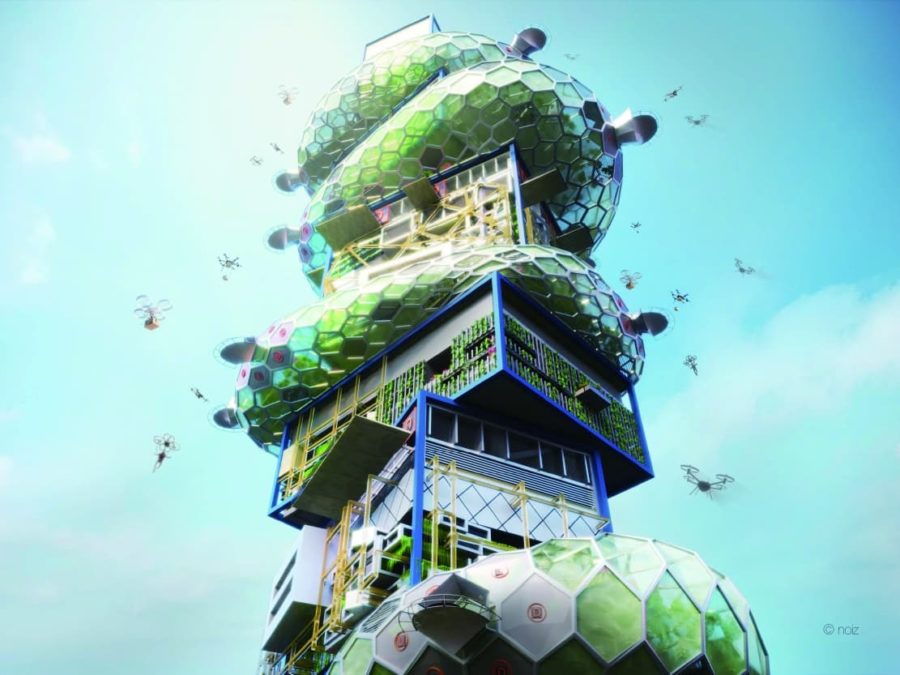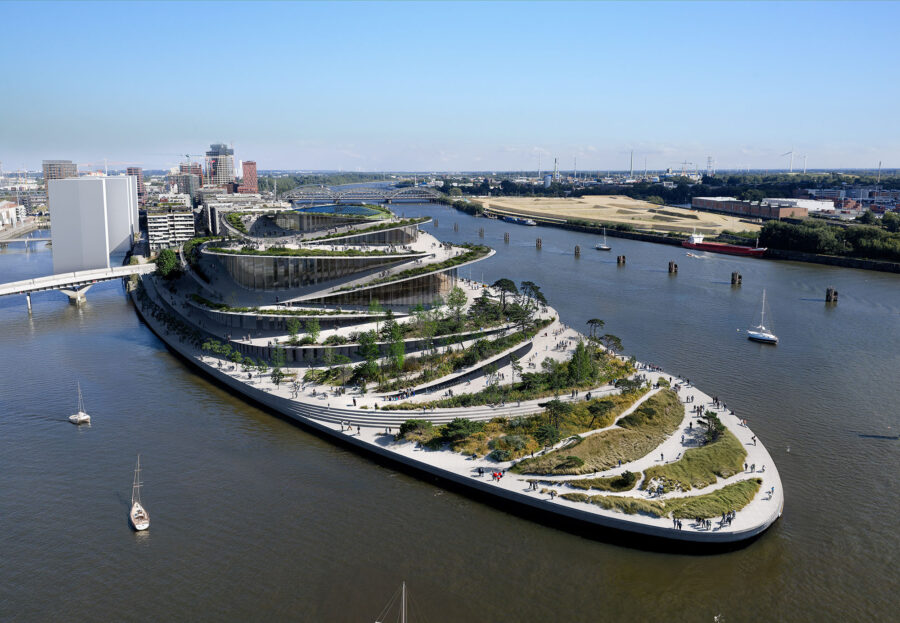
CULTURE


©︎ Simon Whitbread

©︎ Simon Whitbread
オーストラリアのシドニーに位置する〈ロコモティブ・ワークショップ(Locomotive Workshop)〉は、130年の歴史をもつ機関車工場を改修した、イベントスペースやコーヒーロースター、フードマーケット、ワークスペースなどを含む商業施設です。
新たな内部開発は中2階レベルまでに制限することで、遺産的な屋根構造の抜けを強調しつつ新たな施設や店舗とのつながりを生み出しています。
シドニーを拠点に活動するシソンズ・アーキテクツ(Sissons Architects)が設計した、歴史的な建築物を保存するだけでなく現代に適合させ活用する「アダプティブリユース」という考え方を取り入れた建築です。
(以下、Sissons Architectsから提供されたプレスキットのテキストの抄訳)

©︎ Simon Whitbread

©︎ Simon Whitbread
鉄道網の発展を支えた130年の歴史をもつ機関車工場
既存の建物は、オーストラリア鉄道網の拡張を促進するため、機関車と車両の整備と製造に特化した機関車工場として1871年に開設された。
その後の数十年の間に、馬車工場、バネ工場、鋳造工場、塗装工場、大型起工小屋を含む複合施設として規模を拡大していき、1952年のピーク時には1万人以上の従業員が働いていた。このイヴリー機関車工場は100年以上続いたが、1988年に閉鎖された。

©︎ Simon Whitbread

©︎ Simon Whitbread
閉鎖後は技術革新とテクノロジー研究の中心地とするため、ATP(オーストラリアン・テクノロジー・パーク)として運営されてきた。しかし、地域コミュニティに背を向け、孤立したビジネス・パークとなってしまっていた。
オーストラリアの不動産グループMirvacがこの地区全体の再生に乗り出したことは、これまでの良くない傾向を逆転させる機会となった。

©︎ Simon Whitbread
地域コミュニティとのつながりを取り戻す再開発
このような状況の中、当初から私たちのデザイン・アプローチは、障壁を取り除き、門戸を開き、ATP(オーストラリアテクノロジーパーク)地区を周辺地域に再統合することであった。
〈ロコモティブ・ワークショップ〉の開発における全体的な設計意図は、既存の調和を欠く要素をすべて取り除くことで、インダストリアル・スタイルや既存の重要な遺産を明らかにすることにある。

©︎ Simon Whitbread

©︎ Simon Whitbread
再開発されたベイ1と2には鍛冶屋と遺産展示スペースが含まれる。鍛冶屋の工房を存続させることにより、この同じ場所で130年続いた鍛冶業の伝統を守っている。隣接するレストランには遺産が展示されており、より多くの来訪者がこの土地の人々や歴史、成り立ちに触れることができる。
ベイ3と4aはイベントスペース、コーヒーロースター、フードマーケットといった商業スペースとなっており、ベイ4〜15にはワークスペース、最終ベイには遺産の保管・展示スペースが設けられている。

©︎ Simon Whitbread
歴史的な要素を際立たせる全体構成
新たな内部開発は中2階レベルまでに制限しており、遺産である屋根構造や鋳鉄の柱、天井クレーンなどに対してオープンな工業的な景色を維持している。
このアプローチにより、既存の建物と新たな商業施設や店舗との間に強いつながりが復活する。

©︎ Simon Whitbread
構造面から計画には軽量な部材を使用することを基本としている。新しい要素はすべてスチールフレームで構成されており、可逆性をもたせつつ伝統的な質感との差別化を図っており、新旧の要素が接する部分にはその差異が顕著に表れている。
オリジナルの構造の表面は変更せずに時の経過を感じさせるパティナ(古色)を残し、新しい構造体はほぼ黒一色とすることで、新旧の違いをより際立たせている。
この再開発は、長期的な経済性と敷地の活性化を確保する運営体制の中で、建物、収蔵品、ストーリー、空間の卓越した文化的・美的遺産価値を保存し、際立たせ、強調することを目的としている。

©︎ Simon Whitbread

©︎ Simon Whitbread

Plan

Elevation

Section

Section
以下、Sissons Architectsのリリース(英文)です。
Project Information:Project Name: Locomotive Workshop
Completion Year: 2023
Gross Built Area (m²/ ft²): 20,000sqm
Project Location: South Eveleigh, Sydney, NSW, Australia
Program / Use / Building Function: Workplace, Blacksmith, Retail, Event Space
Architects: Sissons Architects, in association with Curio Projects, Buchan and Mirvac Design
Website: www.sissons.com.au
Firm Location: Sydney, AustraliaProject Description:Opened in 1871, the Locomotive Workshops were dedicated to the servicing and manufacturing of locomotive and rolling stock to aid the expansion of the Australian railway network. Over the subsequent decades, the complex grew in scale encompassing the Carriage Works, Spring Shop, the Foundry, the Paint Shop and the Large Erecting Shed. At its peak in 1952, the site was fully occupied with over 10,000 people.After over 100 years of continuous operation, The Eveleigh Locomotive Workshops closed in 1988. Since its closure, the site has been operating as the Australian Technology Park, an attempt to create a centre of innovation and technology research. The unfortunate outcome, however, was the creation of a soulless and isolated business park, which turned its back upon the local community.The revitalisation of this entire precinct by Mirvac was an opportunity to reverse this trend. From the outset, our design approach was to remove these barriers, open the doors and reintegrate the ATP precinct into the surrounding neighbourhood.The overall design intent of the development of the Locomotive Workshops is to remove all existing unsympathetic elements and provide a clear interpretation and expression of the industrial style and significant heritage fabric, including the existing moveable heritage collection.The redevelopment includes the Blacksmith and heritage interpretation spaces in Bays 1 and 2. The continuation of the Blacksmith Workshop preserves the tradition of a 130-year long blacksmithing trade in this same location. The adjacent Heritage Interpretation restaurant will be part of the heritage experience, allowing more people to understand the people, history and origins of the site.Retail spaces, including an event space, coffee roastery and a food market, are located in Bays 3-4a. New Grade-A workspaces are provided in Bays 4-15. The final bay also provides end-of-trip facilities and heritage storage and display spaces.New internal development has been restricted to a maximum of one mezzanine level, open to the heritage roof structure, to retain the views and vistas to and from key locations. This approach reinstates a strong connectedness between the original fabric of the building and commercial and retail new fit outs. This includes views of the volume of the building and its significant elements, such as the cast iron columns, roof trusses, steel girders and overhead cranes. Heritage interpretation elements, including all of the original machinery, are incorporated throughout the project.Structurally, the design philosophy is based upon lightweight interventions within the building envelope. All new elements are steel framed allowing for reversibility and differentiation with heritage fabric. A light touch is employed throughout and is especially evident wherever new and the old interface with one another. All original structure is to remain unchanged with its patina revealing the passage of time. New structure will be almost exclusively black, to differentiate old and new built fabric.The redevelopment aims to preserve, accentuate and emphasise the exceptional cultural and aesthetic heritage values of the building, its collections, stories and spaces within an operational framework that will secure the long-term economic viability and activation of the site.Photography:Photo Credits: Simon Whitbread
Photographer’s Website: https://www.simonwhitbread.com.au/
「Locomotive Workshop」Sissons Architects 公式サイト
https://sissons.com.au/projects/workplace/locomotive-workshop/





![[大阪・関西万博]主要・共用施設紹介_太陽のつぼみ](https://magazine-asset.tecture.jp/wpcms/wp-content/uploads/2025/09/07221227/ts08_O1A0975-900x602.jpg)



